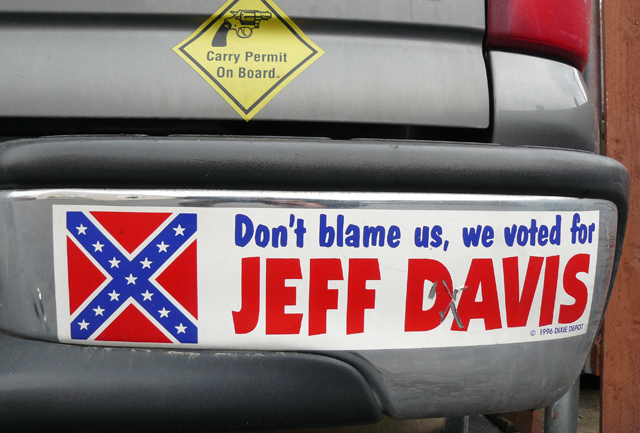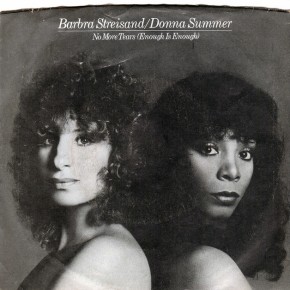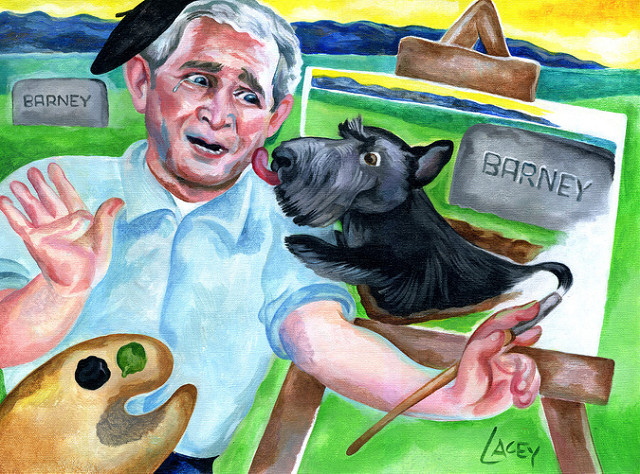I’m not sure why I kept watching after Bill Clinton had finished his victory speech back in November, 1992. People don’t usually care what the future Vice President has to say. But something in Al Gore’s manner compelled me. Six minutes in I found out why: “It is, symbolically, an expression of the reality that sectional wounds of the past are finally and irrevocably healed.”
I turned to my friend in surprise: “Did he just declare the end of the Civil War?” I knew that there had been discussion during the campaign of the fact that both Clinton and Gore were from the South. Still, it seemed more than a little perverse to complicate the hopes for the future that he and Clinton had just been expressing with a reminder of the nation’s painful past.
That strange moment came back to me forcefully during coverage of the recent shootings in Charleston, South Carolina. As it became clear that Dylan Roof’s actions represented a carefully planned act of racial terrorism, the iconic battle flag of the Confederate States of America in which he had both literally and figuratively draped himself came under fierce attack.
The excuse that white people in the South had been using for decades, that the “Stars and Bars” had simply become a way for them to express pride in their heritage, no longer had the power to override the concerns of those who find the flag excruciating reminder of the most disturbing chapters in American history, from slavery itself through the post-Reconstruction era of racial segregation known as “Jim Crow” up to the slaying of civil rights activists in the 1960. Despite the spirited resistance of some conservative politicians and pundits, a series of moves were rapidly made to minimize the flag’s presence in civic life.
In spite of the lingering anguish from the tragic events in Charleston and numerous questionable deaths of African-Americans at the hands of police in recent years, including Oscar Grant, Michael Brown, and Eric Garner, this sudden shift in public opinion rekindled hope for many. When considered alongside the Supreme Court’s decisions last week to let President Obama’s Affordable Health Care Act stand and to extend the legitimacy of same-sex unions to residents of all fifty states, the backlash against nostalgia for the Confederacy felt like a crucial threshold, the point beyond which old intolerances would no longer be permitted to go unchallenged.
As I tried to make sense of this surprising pendulum swing, however, I couldn’t help but wonder about its implications for the sectional wounds of both the past and present. Surely, the people who had felt so strongly about overturning Obamacare, preventing gay marriage and communicating their rebellion against Washington were not all going to suddenly confess the errors of their ways. That kind of grassroots social change takes a lot longer to realize. And it can be actively hindered by the conviction that judicial and legislative actions have ushered in a new era.
Thinking back on Al Gore’s election night speech in 1992, I realized what had made it so unsettling. It wasn’t simply the fact that he had thought it necessary to declare the Civil War over, but also that this peculiar fiat seemed likely to enflame passions that had been cooling off for decades. Sure enough, within months of entering the Oval Office, President Clinton found both his person and his policy recommendations the subject of relentless critique from the Right. By the time the midterm elections of 1994 rolled around, almost all of the progressive elements in his agenda had been dispensed with and the savage war on “political correctness” was at its apex. Statements of overt racism and sexism that had been taboo since the 1970s were now the fuel for higher television and radio ratings. Despite a massive economic boom taking flight in high-tech industries, the United States seemed to be rushing headlong back into the past.
As many commentators have noted, the right-wing backlash against any and all manifestations of “liberal” thinking witnessed during the first Clinton Administration provided the template for the even more intense response to Barack Obama’s arrival in the White House. History seemed to be repeating itself, but with an extra twist of the knife. Particularly noteworthy were developments in the former Confederacy, where the Democratic Party’s surprising success in some of the region’s more economically and culturally diverse states — North Carolina and Virginia — during the 2008 election was rapidly countered by an amplification of Southern resistance to perceived Federal intrusion into matters better handled at the state and local level.
First and foremost, this meant an ideologically rigid repudiation of the Affordable Health Care Act, whose opponents referred to it almost exclusively and, for them, derisively as Obamacare. Six years later, despite two Supreme Court decisions upholding the vast majority of the plan, it remains a rallying cry for conservatives around the country, but especially in the South. This intransigence has often baffled foreign analysts trying to make sense of the “state of the States”, particularly those who hail from nations where nationally managed healthcare has been entrenched for decades. The fact that the AHCA would disproportionately benefit those very states where resistance to it has been strongest — because they have a greater percentage of people who fall into the category of the working poor — only makes things more confusing.
This is where the notion of “sectional wounds” proves especially illuminating. It has often been pointed out that the South benefits more from activities conducted or supported by the Federal government, such as the operation of military installations and defense contracting, than the rest of the United States. Yet this seeming largess has done little to diminish suspicion of Washington throughout the region. Any Federal undertaking that doesn’t directly pertain to the work of the military is likely to be met with outright hostility, as the AHCA most certainly has been.
No matter how seemingly irrational the animus may be — why repudiate something that is going to improve the quality of life for many of your neighbors? — it has shown no signs of dissipating, despite all the ways in which the South has become more like the rest of the country. Although numerous explanations have been offered for this phenomenon over the years, the most obvious one remains the best: many Southerners would rather bite the proverbial hand that feeds them than renounce a regional identity inextricably bound up with the sectional disputes of the early nineteenth century.
It’s possible — likely, even — that Al Gore’s declaration back on election night in 1992 was an attempt to disable this rebellious impulse in advance, because he and his speechwriters were already worried that their exclusively Southern ticket still wouldn’t be enough to elevate the standing of Washington throughout the former Confederacy. That this rhetorical move didn’t work — and, indeed, was barely noticed at all — indicates the degree to which Southerners need to imagine themselves as rebels takes precedence over other concerns. Sometimes this manifests itself in simple and even silly ways, such as disabling the Federally mandated pollution controls on one’s vehicle. Sometimes it takes a more sweeping political form, as in the years spent trying to dismantle the AHCA. And sometimes, as we have seen in the wake of the Charleston shootings, it assumes a brutal shape hearkening back to Jim Crow days, in the burning of African-American churches.
While defenders of the South can rightly object that many, even most, of these acts of resistance are the work of a small minority, it is a lot harder to argue with the big picture to which they add up. My point here is not to excoriate the region for being permanently and perversely retrograde, but to consider ways of coming to terms with the social and political costs of its dearly held identity. Is there a way to imagine a “Southern pride” that does not inevitably lead back to those sectional wounds Gore spoke about? What would a progressive Southern agenda look like if it were not simultaneously an effort to make the region less overtly Southern?
These are questions that have been pondered by people with far more expertise than I, both from within the South and without. Frequently, a suggestion is made to shift attention from politics to culture, with food, drink and music coming to the fore. It’s easy to see why, since taking pride in these categories almost inevitably requires an acknowledgment of the interpenetration of white and black culture. When you celebrate “down-home” cooking or the blues, race ceases to be the dividing line that it otherwise remains inhabitants of the region.
As much as I applaud such efforts, however, I think they sidesteps the problem. Because when the cultivation of political rebellion is so widespread, no amount of cultural engagement is going to bring about fundamental change. Or, to state the point differently, when political rebellion has been transformed into a cultural investment, as is so obviously the case throughout the South, celebrating culture that is expressly not politicized is beside the point. Barbecue and stock car racing, stately gardens and William Faulkner novels, country music and the Delta blues can all be enjoyed without also honouring the legacy of the Confederacy. But the fact that the minds of many white Southerners — and black ones, too, though for different reasons — are drawn ineluctably to the Stars and Bars while they enjoy them demonstrates the difficulty of separating what has been forcibly held together for so many years.
In other words, there is a crucial difference between doing something all by yourself and being made to do it by those you resent for being your masters. It’s a lesson the United States would be well advised to incorporate into its foreign policy, given the resentments that its attempt to impose democracy — or “democracy”, if you prefer —have inspired. But it’s also one that remains pertinent domestically, in light of the what has happened in the South since its brief existence as a sovereign nation. Even if the Federal government still holds the final say, creating more room for autonomy at the state and local level could go a long way towards keeping that impulse to rebel in check.
What might this have looked like, in the case of the Stars and Bars? Because Washington doesn’t actually control the media, despite what conservatives believe, there may not have been much room to maneuver. Still, greater effort could have been made to acknowledge that the flag doesn’t only mean what Dylan Roof and other perpetrators of racial hatred presume. No matter how intertwined the icon may be with the legacy of the Confederacy, there is ample evidence that its meanings have multiplied over time.
Many people have made analogies between the Confederate battle flag and the National Socialists’ use of the swastika as an emblem. If postwar Germany banned all Nazi iconography, the reasoning goes, why can’t the United States do the same with the Stars and Bars? The answer, simply, is history. Because the Confederate battle flag wasn’t banned after the Civil War or at any subsequent point until now, it developed layers of significance that cannot be reduced to its original meaning. To be sure, plenty of people have deployed it — and, like Dylan Roof, continue to do so — as an emblem of racial separatism explicitly intended to honor the legacy of the Confederate States of America. But more have used and, from the perspective of the previous category, abused it in ways that are more tenuously linked to that legacy.
There’s no denying that these other applications refer in some way to the sectional wounds Al Gore spoke of. The animus towards Washington — or, more accurately, everything that “Washington” has come to stand for metonymically — is always lurking there somewhere. At the same time, however, to pretend that the Stars and Bars means exactly the same thing that it did in 1863 or 1910 or 1962 is to be guilty of the same specious “originalism” that conservative Supreme Court Justices like Antonin Scalia have used to justify their retrograde opinions.
What I’m suggesting here is that, if we want the United States’ Constitution to be treated as a living document — as anyone on the Left assuredly should — then we also need to treat the Stars and Bars as one as well. Banishing it from civic life will not banish it from the hearts and minds of those who have been stirred by its different meanings. While there are clearly good reasons for removing it from official buildings in Southern states, making it forbidden in other contexts, as the NASCAR stock racing circuit intends to do, is likely to backfire.
It’s also worth asking whether removing the flag from the public sphere will end up concealing the very institutional racism that it is supposed to stand for. The fact that Southern states like South Carolina, Mississippi and Georgia at least partially sanctioned the Stars and Bars’ display after the Civil Rights Movement is not something we want anyone to forget. In that regard, an argument could be made that it would be more desirable to increase the flag’s visibility, albeit in settings where its history is better contextualized, than to conceal it from view.
Researching the ways in which the Confederate battle flag has been deployed since the 1960s, I was struck by the lack of a common denominator. Even the television series Dukes of Hazzard, which was recently withdrawn from syndication by the TV Land cable network because the “General Lee” car driven by its heartthrob protagonists displayed the flag on its roof and played “Dixie” on its horn, is not as easy to condemn as might initially seem to be the case. Yes, the car provides an easy target, an example of how thoroughly the legacy of Southern exceptionalism was able to be repurposed at the dawn of the Reagan Revolution into a national. But anyone who actually watched the show — as I did, religiously — knows that it concentrated the vast majority of its narrative energy on the idea of rebelling against authority figures and almost went out of its way not to seem racist.
Now, I recognize full well that defending the General Lee right now is a fool’s errand. But there are other ways of complicating our sense of what the Stars and Bars has stood for. For example, back when Jimmy Carter won the Presidency in 1976, much was made of his southern origins. Although his election team went out of its way not to remind people of the region’s recent past, including George Wallace’s segregationist campaigns for President, that didn’t stop his supporters from displaying their pride in a button-pushing manner, sometimes literally.
None of the official materials promoting the Carter-Mondale ticket went anywhere near the Stars and Bars. Indeed, perusing them now, it is striking how many feature the color green, which has more or less disappeared from both Republican and Democratic iconography in the post-9/11 era. Part of that has to do with wanting to distance Carter from any problematic Southern associations. But a full explanation must also mention his campaign’s desire to present him as an innovator, not afraid to break with dearly held traditions.
Like the Bill Clinton and Al Gore sixteen years later, Carter’s political identity was bound up with the image of the New South, a place where backwards racial and social attitudes were supposedly giving way to a more diverse economic and cultural worldview. This was the era in which the idea of the Sunbelt was being expanded to include the heartland of the former Confederacy as well as the always somewhat anomalous Florida and the desert Southwest, as powerful waves of “reverse migration” brought in residents whose historical ties lay in the Northeast and Midwest.
Although many of these newcomers were retirees, a demographic not noted for its liberal outlook, plenty of white and blue collar workers and their families became provisional Southerners as well. And, while there is no doubt that at least some of them were drawn to the former Confederacy because of their own conservatism and, at times, outright racism, a greater percentage had little investment in natives’ romanticized view of their regional history.
That is why it seemed, throughout most of the 1970s, that the trend towards a dilution of Southernness would continue to amplify until regionalism had lost most of its ideological force there. But a strange thing happened on the way to this “Post-South”. Rather than continuing to fade into history, the conservative white fantasy of the former Confederacy as a place where traditional values still mattered started to spread to other parts of the United States where the legacy of postwar progressive movements was starting to lose its luster. Maybe the Southernness of the actually existing South was being diluted by northern influences, but it was also being dispersed into regions that had once been resistant to its appeal.
The reasons for this surprising reversal are complicated, ranging from the lingering effects of Lyndon B. Johnson’s betrayal of the Dixiecrats in his party through the rise of Ronald Reagan’s brand of conservatism to the resurgence in religious feeling that was both a product of and a reaction to the imagined — and sometimes real —excesses of the counter-culture. In business, a “Southern Model” held great appeal to investors because they thought it could be used to counter the clout of organized labor, which had been building since the 1930s. And then there’s the simple truth that, after decades of being pushed headlong towards a homogeneous national culture seemingly without “soul”, a lot of Americans had become nostalgic for any and all forms of regional identity. It’s just that the former Confederacy was better endowed in that regard than, say, the Pacific Northwest.
As this dispersion of Southernness picked up steam throughout the 1970s and 1980s, with the increasing popularity of NASCAR and country music, it had a way of making strange bedfellows. Politicians and artists who were strongly opposed to celebrating anything tied to the legacies of slavery and segregation found themselves swept up in waves of indiscriminate Southern Pride. It even happened to Jimmy Carter in 1976, to a degree. He received a lot of support from the Allman Brothers Band, for example, which had been integrated since the 1960s and saw itself as a standard bearer for the New South’s countercultural equivalent.
But old habits are hard to break and both Carter and his rock and roll allies found themselves in situations where they were linked to the Confederate battle flag, despite repudiating most of what it had traditionally stood for in the post-Reconstruction South. Consider the implications of the Allman Brothers 1974 tour program. In our current post-Charleston climate, it would almost certainly be regarded as a form of dangerous nostalgia, promoting a treasonous and inhumane ideology at the expense of the openness towards difference that has made the United States great. The question, though, is whether this assessment would be a fair one.
If we see a photograph of Jimmy Carter from when he was still Governor of Georgia, standing near a Stars and Bars hung by the descendants of American Southerners living in Brazil, are we to conclude that his feelings about African-Americans had evolved considerably by the time he became President? Or, rather, that his public welcoming of diversity masked the diehard racial attitudes of the Old South? Should he be excoriated for visiting this strange settlement, explicitly created as a refuge for those who were fleeing a world deprived of the institution of slavery? Or might it, instead, make more sense to conclude that he wanted to honor members of his wife’s family without in any way endorsing the ideology that led them to emigrate?
These are not easy questions to answer. Few of the ones raised by the use of the Stars and Bars. Yet that does not mean that we should avoid taking them seriously. As satisfying as banishing the flag might be under current circumstances, the problems we are likely to face for doing so must not be taken lightly. Not only is the political identity for which the flag stands likely to persist regardless of what is permitted in public life, there is also a very good chance that it will seek expression in other ways, including ones that make critiquing its connection with racism a lot harder. The American flag can be waved for lots of reasons as well, some of them almost as unsavoury as the ones we associate with the Stars and Bars. Just ask the people we have detained and tortured without any semblance of due process. Or the communities destroyed by missiles launched in the name of freedom.
Lead photo courtesy of the author. Self-portrait of Dylan Roof derived from his website. All other images culled from internet shopping sites.









